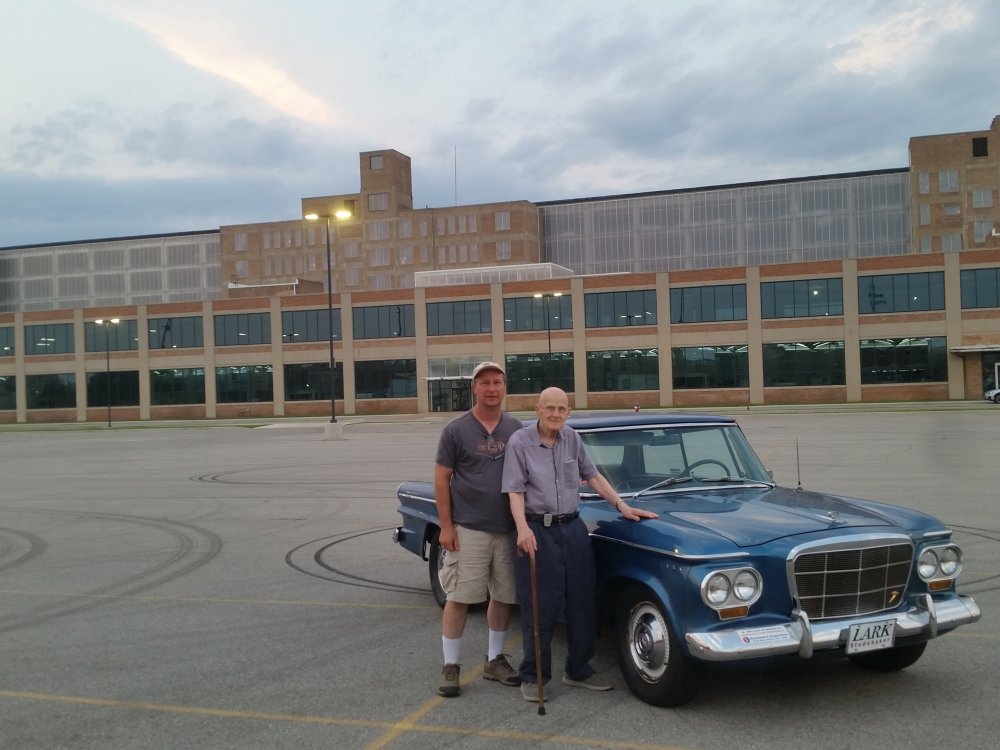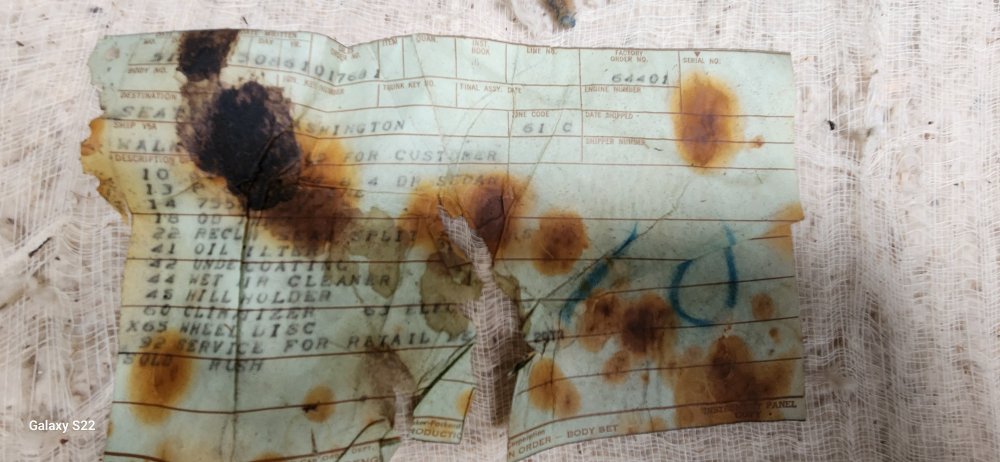
Mark L
AOAI Forum Members-
Posts
186 -
Joined
-
Last visited
Content Type
Profiles
Forums
Events
Everything posted by Mark L
-
It's looped inside the pillar and held with something like a clip. When I replaced my vent hose I cut the visible ends just below the pillar and shoved it up inside the pillar to get it out of the way. If I ever remove the interior lining of the pillar, I'll remove the clip and cut portion of the hose.
-
The large hole in the middle can be plugged with a metal or rubber body plug of the same diameter. I used a metal plug to make it less likely for a mouse to chew through it. The smaller hole to the right of it is where the gas tank vent tube passes through the body.
-
As pictured in post 5, deluxe trim had smooth, perforated vinyl inserts on the seat backs and bottoms. The regal trim had pleated vinyl with no perforations.
-
Thanks. He spent most of his time at Studebaker working in building 84. This is the two of us outside buildings 84 and 113 in September 2021. My youngest daughter and I stopped in South Bend to visit my parents after driving my '62 Lark Daytona hardtop to the SDC International Meet in Indianapolis. That was a long, hot trip. He passed about six weeks later, and my mother about 10 weeks after him.
-
Wow, a 16 year old boy with a new Avanti. I'm speechless. Just...wow.
-
Yes. My father worked in the auto assembly building in South Bend. He was in the Production Control department. One of his duties was to collect copies of the production orders as the cars came down the assembly line and turn them in so they could be filed.
-
Regarding my response in post 3 above, this is a photograph of the production order that was found in the dashboard of our chapter member's 1961 Cruiser. In the bottom center it says "Production Order - Body Set". In the bottom right corner, it says "Instrument Panel Copy". This does not specifically answer the question in post 1 above.
-
63stick, it's yours. I just sent you a Private Message requesting your mailing address. For your privacy, please do not post it in this thread.
-
One of our local SDC chapter members is selling a 1961 Lark Cruiser. He said he found a copy of the build sheet tucked up into the dashboard near the glove box. It certainly looks like it was in the car for quite a few years.
-
I have an extra 2025 calendar available for free. It was sent to me to pass along to someone else, but that person already has one and didn't need it. I'll even pay the shipping.
-
The third Avanti sold to the public, 63R1003, is available. It was donated to the Studebaker National Museum, and the museum is now auctioning it through the Hagerty Marketplace with no reserve: https://www.hagerty.com/marketplace/auction/1963 -Studebaker-Avanti/a674bfb8-d821-492c-97ff-496058ccb07a The car is pretty rough. White with orange interior. 289 with serial number RS1003. Body 63RQ 105. 4-speed manual transmission, power steering, power brakes, twin traction, aftermarket AM/FM radio. The supercharger was removed at some point and replaced with air conditioning.
-
In the parts catalog illustration in post 2 above, illustration number 1110-40 is a threaded rod that passes through the center of illustration number 1110-16. There is a nut threaded on the rod on the front-facing side of 1110-16, and another nut threaded on the rod on the rear-facing side. Turning the nuts toward the front of the car will apply more brake (or apply it earlier with less handle travel) as the handle is pulled. Turning the nuts toward the rear will apply less brake (or apply it later with more handle travel) as the handle is pulled. If it's been a long time since the nuts have been adjusted, it is very likely the threads of the rod will be rusty with a lot of road dirt and debris embedded in the threads. It may be a good idea to first remove the nuts and 1110-16, run a thread die over the threads on the rod, and run a thread tap through the threads on the nuts. This will clean them out and make it much easier to adjust the nuts when it is reassembled.
-
I just completed the following: New flanged rear axles Turner disc brake conversions, front and rear All new brake tubes All new flex hoses New dual master cylinder Eliminated the hydraulic stop light switch and installed a mechanical switch at the brake pedal. The port on the MC for the hydraulic switch is plugged and sealed. Today I filled the system with fresh DOT 4 fluid and bled the brakes. I found two leaks in the rear circuit. I tightened the leaky fittings and bled the rear brakes again. With the engine not running, the brakes feel firm as they are applied, and I can see the booster and master cylinder flexing upward slightly very soon after I start pressing the pedal and as resistance builds up in the pedal. This is the problem. The car is completely off the ground on jack stands and the wheels off. When I start the engine and apply the brakes, the pedal goes almost to the floor before I feel any solid resistance in the pedal. The booster and master cylinder do not flex up slightly until the pedal is nearly to the floor. As the pedal is nearing the floor, I can hear a change in tone in the engine as if there is an additional load on the engine. With the engine at idle and the transmission in drive, and no pressure on the brake pedal, the rear axle turns. If I apply the brakes, the rear axle does not stop turning until the pedal is nearly to the floor, which seems to indicate to me that the booster is not applying pressure to the MC until the pedal is near the floor. I removed the check valve on the booster and confirmed it only allows air to move towards the engine. I removed the vacuum hose between the check valve and fitting on the intake manifold and verified it is clear. With the check valve installed and twisted into position, it is still a little loose on the booster. There is one gasket in place. When I installed the MC, I had to shorten the length of the actuating pushrod. The contact point on the piston is at a more shallow depth than the original MC. I adjusted the rod so that the rod is not putting any pressure on the piston as the mounting flange seats on the face of the booster. Lengthing it by one or two flats of the nut changes how the MC seats on the booster, so I know it's adjusted right. What am I missing? What should I check next? I'm not going to drive it until I figure this out. It wasn't doing this before I did all this work. The front brake pads were worn out, but the car was stopping and the brake pedal resistance was better than this.
-
Does anyone have a copy of a membership directory for 1976, or know how I can find a copy? I'm trying to track down a previous owner of my Avanti. The Bob Johnstone Avanti website indicates the 1976 member directory showed an Edward V. Albert in La Mesa California owned the car at that time. He may not live there any more, but I'm trying to connect the dots to see if he's still alive and where he might live now. I was recently given an almost complete collection of Avanti Magazine and newsletters from 2017 all the way back to issue #1 in 1965. I know it's all available on digital media now, but the guy needed to move, and it was free. Would the member information be found in any of the newsletters/magazines from the 1970's? Thank you for your assistance.


